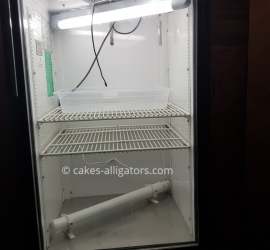The female Chinese Alligator will dig a hole in the top of her nest (see the Nesting page for more info on this) in order to lay her eggs in.
Once she's laid her eggs in this hole, she'll then cover it up with the materials that she's used to create the actual nest - which is usually some sort of undergrowth or other natural material.
In all studies so far of nesting habits, the Mother tends to play a vital role in the process of the egg hatching. She'll stay around the nest during the incubation process in order to scare away any potential predators or other animals which could cause a threat to the eggs.
Towards the end of the incubation process, the mother Chinese Alligator will regularly visit her nest in order to check up on any vocalizations.
When the eggs are hatching, the mother will gently crack open any eggs that appear to need some assistance by using her mouth. Any neonates will be carried by the mother to the nearby body of water.
Note If the mother didn't uncover the eggs whilst hatching, the hatchlings may be unable to dig their way out of the nest.
Once hatched, if a hatchling feels agitated then it'll call out in distress. The mother will then come along, and carry them away from potential danger by taking them in her mouth.
The hatchlings tend to venture into water after around 2 days of life. This may be encouraged by the mother calling out to them.
It's believed that the mother will stay with her young for the first few years of their lives, and they'll remain together over winter until they're capable of digging their own burrows which is at around age 2 or 3 years.

